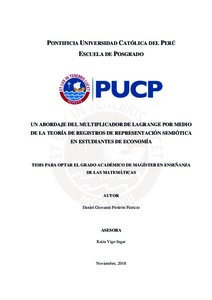| dc.contributor.advisor | Vigo Ingar, Katia | |
| dc.contributor.author | Proleón Patricio, Daniel Giovanni | es_ES |
| dc.date.accessioned | 2019-02-08T14:00:06Z | es_ES |
| dc.date.available | 2019-02-08T14:00:06Z | es_ES |
| dc.date.created | 2018 | es_ES |
| dc.date.issued | 2019-02-08 | es_ES |
| dc.identifier.uri | http://hdl.handle.net/20.500.12404/13415 | |
| dc.description.abstract | El presente trabajo tiene como objetivo analizar la coordinación de las Representaciones en los
Registros de Representación Semiótica (gráfico, algebraico y natural) que estudiantes de
Economía de una universidad particular de Lima, realizan cuando desarrollan una situación
problema relacionada al Multiplicador de Lagrange. Para poder llevar a cabo este trabajo,
hemos revisado antecedentes de investigación que tienen como objeto matemático al
Multiplicador de Lagrange, así como funciones reales de varias variables, ya sea con el empleo
de la tecnología o sin ella. Por otro lado, hemos justificado la realización de nuestra
investigación por medio de aspectos académicos, curriculares y personales para poder mostrar
la pertinencia del presente trabajo. El marco teórico empleado pertenece a la Teoría de Registros
de Representación Semiótica (TRRS) de Duval (1995), mediante el cual podremos analizar las
coordinaciones realizadas por los estudiantes cuando resuelvan una situación problema. El
referencial metodológico empleado es Aspectos de la Ingeniería Didáctica (ID) de Artigue
(1995), cuya estructura guiará nuestra tesis. Con respecto a la etapa experimental, se escogieron
dos parejas de estudiantes, quienes resolvieron una situación problema de una actividad, en la
cual utilizaron el software Geogebra para su realización. Para finalizar, se realizó el análisis de
los resultados obtenidos en la situación problema, en el cual se confrontaron los análisis a priori
y a posteriori, para observar si los resultados obtenidos fueron los esperados por el investigador.
Siendo así, se concluye que el software Geogebra favorece la conversión de representaciones
en el registro algebraico para representaciones en el registro gráfico. Por otro lado, el uso de la
TRRS permitió identificar las dificultades por las cuales los estudiantes no lograron la
coordinación de registros. | es_ES |
| dc.description.abstract | The main objective of the present work is to analyze the coordination of the Representations in
the Registries of Semiotic Representation (graphic-algebraic-natural language), that students of
Economics, of a public university in Lima, perform when they develop a problem issue related
to the Lagrange Multiplier (LM) to carry out this thesis, we have reviewed research
backgrounds that has have as a mathematical object of study the LM, whether it is with the use
of technology or without it. Also, we have reviewed and analysed the applications that are
presented in the experiments carried out in those investigations, as well as the use of the
instruments used for data collection, which serves as a guide for the design of the activities
present in the problem situation . On the other hand, we have justified the realization of our
research taking into account the academic, curricular, personal and professional aspects in order
to show the relevance of the execution of our work. The theoretical framework use is that of
the Theory of Registries of Semiotic Representation (TRRS) of Duval (1995), provides us with
valuable and necessary tools to understand and interpret the transformations made by the
subjects of research when a problem situation occurs. Likewise, we have chosen as a
methodological reference aspect of the Didactic Engineering (ID) of Artigue (1995) whose
structure will guide our tesis. To carry out the experimental stage, we have chosen two couples
who will participate in a problematic situation, composed of two activities, in wich they used
the Geogebra software for its realization. Finally, an analusis was made of the results obtained
from the problematic situation, in wich we compared the a priori analysis and the a posteriori
analysis, the characteristic of the ID, to observe whether the results were or were not predicted
by the researcher. Thus, it is conclude that the use of the GeoGebra software favours the
conversion of representations in the algebraic register for representations in the graphic register.
On the other hand, the TRRS allows us to explain how conversions and treatments are
developed, also to identify the difficulties for which students do not manage to coordinate. | es_ES |
| dc.language.iso | spa | es_ES |
| dc.publisher | Pontificia Universidad Católica del Perú | es_ES |
| dc.rights | info:eu-repo/semantics/openAccess | es_ES |
| dc.rights.uri | http://creativecommons.org/licenses/by-nc-nd/2.5/pe/ | * |
| dc.subject | Economía--Estudio y enseñanza | es_ES |
| dc.subject | Matemáticas--Estudio y enseñanza | es_ES |
| dc.subject | Ecuaciones de Lagrange | es_ES |
| dc.subject | Semiótica | es_ES |
| dc.subject | Educación superior--Perú--Lima | es_ES |
| dc.subject | Universidades--Perú--Lima | es_ES |
| dc.title | Un abordaje del multiplicador de Lagrange por medio de la teoría de registros de representación semiótica en estudiantes de economía | es_ES |
| dc.type | info:eu-repo/semantics/masterThesis | es_ES |
| thesis.degree.name | Maestro en la enseñanza de las Matemáticas | es_ES |
| thesis.degree.level | Maestría | es_ES |
| thesis.degree.grantor | Pontificia Universidad Católica del Perú. Escuela de Posgrado | es_ES |
| thesis.degree.discipline | Enseñanza de las Matemáticas | es_ES |
| renati.discipline | 199117 | es_ES |
| renati.level | https://purl.org/pe-repo/renati/level#maestro | es_ES |
| renati.type | http://purl.org/pe-repo/renati/type#tesis | es_ES |
| dc.publisher.country | PE | es_ES |
| dc.subject.ocde | https://purl.org/pe-repo/ocde/ford#5.03.01 | es_ES |






